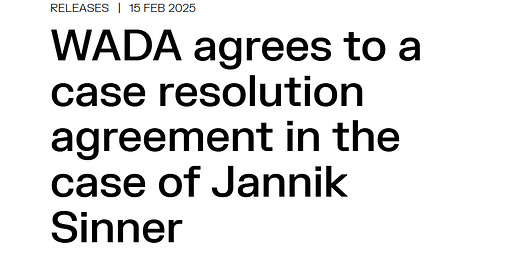Sinner Sidelined, But Spared the Worst
Jannik Sinner and WADA found a compromise in the timing of a three-month ban; he might still lose the No. 1 ranking.
Perhaps the most crucial, existential question for this season of men’s tennis was suddenly answered Saturday morning, as the World Anti-Doping Agency (WADA) announced that it had reached a settlement in the case of Jannik Sinner, resolving the matter two months before a planned hearing date at the Court of Arbitration for Sport (CAS) in April.
Sinner, the dominant ATP No. 1 who just won his third major title at the Australian Open a few weeks ago, accepted an offer to serve a ban of three months, backdated to start on February 9th and also including four days of time-served credit for when he quietly served a provisional suspension last year.
Here’s the key part of the announcement posted by WADA on Saturday:
“The circumstances surrounding this specific case meant that in order to ensure a fair and appropriate outcome, WADA was prepared to enter into a settlement agreement, in accordance with Article 10.8.2 of the World Anti-Doping Code.
“WADA accepts the athlete’s explanation for the cause of the violation as outlined in the first instance decision. WADA accepts that Mr. Sinner did not intend to cheat, and that his exposure to clostebol did not provide any performance-enhancing benefit and took place without his knowledge as the result of negligence of members of his entourage. However, under the Code and by virtue of CAS precedent, an athlete bears responsibility for the entourage’s negligence. Based on the unique set of facts of this case, a three-month suspension is deemed to be an appropriate outcome.”
An Amenable Agreement:
This is, as indicated by the ability of the two sides to agree upon the terms, an outcome that both sides could ultimately see as favorable.
For WADA, they get to avoid a dangerous precedent that an athlete can escape all responsibility for a positive test by blaming it on the negligence of his or her entourage. The “no fault or negligence” verdict found by the initial panel convened by the International Tennis Integrity Agency (ITIA) was maximally favorable to Sinner, and took his entire story—and all the details that were carefully included to reach the verdict that was achieved—without challenging any part of the facts. WADA opted not to challenge the facts of the case either, but still was unhappy with how generous the initial verdict had been, hence their appeal. WADA had stated that they were seeking a ban of 1-2 years, but an outcome in this range of a few months was considered likely.
As I wrote back in January when the April appeal hearing date was announced:
While the news of a hearing date may ease some of the anxiety caused by uncertainty for Sinner, a mid-April date for his hearing is bad news for the viability of his 2025 season.
While WADA has said it is seeking a 1-2 year ban, consensus has been that a shorter penalty of 1-3 months is most likely in this case if CAS overturns the original verdict. If the hearing had been in February, a ban in that range that could have been served to completion without Sinner being forced to miss a Grand Slam event. But with a mid-April hearing, a ban of that length could easily straddle both the French Open and Wimbledon, and perhaps even the U.S. Open if a fourth month (or beyond) is also handed down.
An announcement coming months ahead of schedule, therefore, is also a huge win for Sinner. Though three months was on the upper range of penalties that were considered likely, it slots into the calendar at an ideal time for him: after his Australian Open title defense and before the next major rolls around at the French Open. In fact, since Sinner will be eligible to return on May 5th, he will be able to have his comeback event at the Italian Open in Rome, which begins just a couple days later.
Will Sinner Lose the No. 1 Ranking?
No. 1- ranked Sinner currently has a comfortable 3,695 points ranking cushion over No. 2 Alexander Zverev, whom he just thrashed three weeks ago in the Australian Open final.
Sinner will have 2,100 points fall off his ranking before Rome, including 1000 points from his win at the Miami Open last year.
Zverev, who just lost yesterday in the quarterfinals of ATP 250 Buenos Aires to Francisco Cerundolo, stands as the likeliest to pass the stalled Sinner. Zverev only has 900 points of his own to defend, which isn’t much.
To pass Sinner, Zverev will have to earn 2,495 points in these next three months. That would take some big results from Zverev, but it’s not impossible; he’s set to play four ATP 1000 events (Indian Wells, Miami, Monte Carlo, and Madrid) and at least three ATP 500 events (Rio de Janeiro, Acapulco, and Munich) before Sinner’s return, meaning there’s a maximum of 5,500 points on the table for him. Unless No. 3 Carlos Alcaraz (who is defending 1,000 points in Indian Wells soon) has several big runs, Zverev also figures to be the top seed in all of those draws.
If Zverev does it, he would become the first ATP No. 1 to reach the top spot without winning a major since Marcelo Rios in 1998.
This has a huge impact on Zverev’s career, which he will have to be realizing abruptly; as I wrote in my post-Australian Open notebook, when Zverev was asked about the looming ban of Sinner after the Australian Open final, he seemed completely clueless about the proceedings against the only man ranked above him:
Q. You talk about how dominant Jannik is. How strange is it then that he could kind of get a lengthy ban? How much does that create uncertainty amongst the rest of the players?
ALEXANDER ZVEREV: Wow, I didn't expect that question.
I don't know. I don't know anything about the situation that he's in. I know he's been cleared once. I know someone over the Tennis Integrity Unit is taking a look at it now.
Yeah, I mean, he's a great guy. I have absolutely nothing against him. I don't know what will happen, but let's see in the next few months.
I didn't expect this question, so I don't really know how to answer it, to be very honest.
Melbourne Miscellany
The 2025 Australian Open ended with an unexpected news event after the final ball had been hit, and changing tacks to pursue that story—and to illuminate the woman at its center as a follow-up—felt like the right thing to do for Bounces at the end of the tournament
How Will This Affect Sinner’s Legacy?
As you can tell from Zverev’s response, a lot of top men’s tennis players hadn’t seriously engaged with the details of Sinner’s case, a lack of curiosity that surprises me since he’s so relevant and predominant on the tour. It’s also why Christopher Eubanks’ engaged diligence about Sinner’s case stood out so much.
Sinner’s reputation doesn’t seem to have taken a meaningful hit in the locker room from his positive tests; will him being sidelined for three months, in a settlement deal that some could read as an admission of some guilt?
I think that will be one of the biggest questions for the rest of the tour in the coming months, if Sinner’s absence finally makes them grapple with what his presence in all the months since his positive test has meant. Three months could be a lot of time for them to think about what it all means, both for Sinner and for the sport as a whole.
Thanks for reading Bounces! I am expecting to be off for the rest of this week, but will return with dispatches from the next tournament I’m covering in-person. -Ben









Thanks as always for your informative piece.
I think the headline that Sinner was spared the worst is very much the case, and not just because the “upper range” might have been a 3m ban. I know many were speculating about this before this settlement but in truth, according to the applicable law and CAS case law, the 3m ban was not an available option if CAS had determined he bore no significant fault/negligence in his case given that his ADVR was for a non-specified substance. The TADP does not allow a reduction more than half of the maximum (being 1 year) (hence why WADA were asking for 1-2 years). A 3m ban would accord with a low level of fault/negligence based on the applicable case law, had the substance been a specified substance. As such CAS was facing the prospect of having to decide on no fault at all (0 years banned) and if low fault/negligence (at minimum 1 year). I think WADA’s settlement is recognition that was an unfavourable option for CAS given the basic facts of contamination (which they were not disputing, merely the scope of Sinner’s negligence re his staff) that ran the risk of a bad precedent in either case. In this regard I think it was a pragmatic decision by WADA to potentially avoid a loss (or a win that would have potentially been a bad precedent), and an even more pragmatic assessment by Sinner to avoid a potential longer ban where the relevant law and case law could never have allowed a lower range ban less than 1 year for even low negligence and fault. A 3m ban would never have been available to him at hearing and he would have had to demonstrate no ban at all or face the prospect of at min 1 year even with low fault/negligence.
On the issue of whether the settlement represents an “admission of guilt” by Sinner, WADA has never alleged in its appeal that Sinner intended to cheat and said expressly in its statement announcing the settlement that he “did not intend to cheat” so I am not sure what guilt he would be admitting to beyond accepting that he bore some fault and negligence at the low end.
Nice piece. I saw The Athletic reported that he will be allowed to train from April 13. Is that right? I never heard of suspended players not being able to "train." What does that even mean? He can't run on a treadmill or go for a walk? Seems hard to believe. ... On the last paragraph about players having a lot of time to think about what it means, I'll take the "under" on the thinking. Always take the under on thinking in tennis.